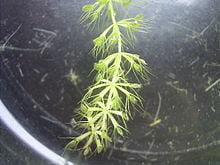Aldrovanda

Aldrovanda /ˌældrəˈvændə/ is a genus of carnivorous plants encompassing one extant species (Aldrovanda vesiculosa, the waterwheel plant) and numerous extinct taxa. The genus is named in honor of the Italian naturalist Ulisse Aldrovandi, the founder of the Botanical Garden of Bologna, Orto Botanico dell’Università di Bologna.[2] Aldrovanda vesiculosa has been reported from scattered locations in Europe, Asia, Africa, and Australia.[1][3][4][5]
The waterwheel is a small, free floating and rootless aquatic plant, with a length of about 1.5 to 20 cm (9⁄16 to 7 7⁄8 in), and whorls of about 1 to 2 cm (3⁄8 to 13⁄16 in) in diameter.[6] At every 3 to 4 cm (1 3⁄16 to 1 9⁄16 in) the plant branches, sometimes forming offshoots. An average of 12 to 19 whorls spans the length of the plant, each with about 5 to 9 leaves, each up to 11 mm (7⁄16 in) long. The growth is faster than terrestrial carnivorous plants, sometimes growing about 4 to 9 mm (3⁄16 to 3⁄8 in) a day.
In temperate regions the plant goes dormant in the winter, forming turions of about 4–6 mm (3⁄16–1⁄4 in) and sinking to the bottom. In tropical regions, the plant grows all year long without forming turions. The plant flourishes and produces seeds only in these warmer regions, with temperatures higher than 25 °C (77 °F), and produces only one flower, white or light pink, that arises above the surface. In temperate regions, the plant reproduces mostly via asexual means, producing inviable seeds or no flower at all.
The leaf structure is very similar to the Dionaea (commonly known as the Venus flytrap), the main difference being air chambers present in the “stem”. The traps, at the end of the leaf, contains up to 6 bristles, analog to the Dionaea teeths, that prevents debris from activating the trap. Each trap contains additional 60–80 smaller “teeth”, and circa 30–40 trigger hairs inside. The speed of closing is about 0.01 to 0.02 seconds.
